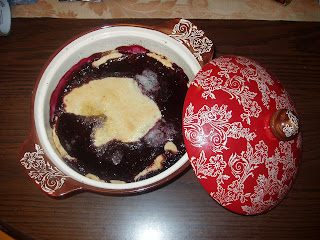A few months ago, I wrote a review for Hall of Fame of Southern Recipes from Mississippi’s Quail Ridge Press. I’m now
reviewing one of their latest cookbooks, Recipe
Hall of Fame: Guilty Pleasures, a pretty comprehensive cookbook of decadent
sweet treats.
My main gripes with many dessert cookbooks are that they’re
either lacking in variety (I don’t need a lengthy tome devoted merely to cakes,
cookies, or even the trendy cupcake) or that the recipes are far too
simplistic. I’ll never forget the occasion when my grandmother submitted her
recipe for Butterscotch Pudding for a local cookbook: 1 box of Jell-O Pudding
Mix, 2 cups of milk. Bless her heart, my grandmother was NOT a cook.
Guilty Pleasures,
however, truly has it all. Not only does it include the usual staples of cakes,
cookies, pies, and so on, but it also features a chapter devoted to easy
recipes incorporating cake mixes as well as a chapter of breakfast sweets. My
personal favorite, of course, is the chapter devoted to cheesecakes – yes, a
chapter of cheesecakes. How titillating does that sound?
One aspect that I especially appreciate is that while the
book presents many of the classics, such as Chocolate Cake, Chocolate Chip
Cookies, Pecan Pie, and so on, it also presents many updated classics-with-a-twist,
like Eggnog Pound Cake, White Peach and Raspberry Cobbler, Chippy Peanut Butter
Cookies (which peanut butter AND butterscotch chips!), and Amaretto Cheesecake
(which I will definitely be making at some point in the future).
Better yet, my very dear friend Emily is responsible for
many of the book’s gorgeous photos, including the front cover!
If you or a family member possesses an undeniable sweet
tooth, you definitely should clear some space on the shelf for this book. It’s
also a great cookbook for holiday planning (my mom and I looked through it
several times for ideas for Christmas treats), and as cliché as this may sound,
it really would be an ideal holiday gift for anyone at nearly any level of
culinary expertise.
When I performed my initial survey of the book, one recipe
in particular stood out to me: Bourbon Pecan Butterscotch Pie. Now, you’ve
heard me extol the virtues of baking with bourbon in some of my previous
entries, and last year at Christmas, I made two Bourbon Pecan Pies that were
ridiculously delicious. So when I first spotted this particular recipe, I was
immediately intrigued.
The pie is very easy to assemble and is out of the oven in
less than an hour. As for the flavor, the butterscotch isn’t as overwhelming as
you might expect. Instead, it’s rather subtle, offering a warm, buttery
compliment to the pecans. An editor’s note for the recipe suggested reducing
the amount of sugar for a less-sweet pie, but surprisingly, I didn’t find the
pie too sweet at all. It’s a delicious balance of all the buttery, caramel-y
flavors, and the faint bite of the bourbon adds a bit of charm to this homey
dish. So, in summation, this pie is freakin’ awesome!
Bourbon Pecan Butterscotch Pie
(From Recipe Hall of
Fame: Guilty Pleasures by Gwen McKee and Barbara Moseley – Published by
Quail Ridge Press in Brandon,
MS)
9-inch unbaked pie shell*
2/3 cup butterscotch chips
3 eggs
1/2 cup sour cream
1/2 cup dark corn syrup*
1 cup sugar
1/8 tsp. salt
1 tsp. vanilla
2 oz. bourbon*
1 3/4 cups pecans
*Personally, I dislike frozen pie shells, because I find
that they tend to break rather easily. I much prefer the refrigerated pie
crusts that you can unroll and place in your own pie dish. However, use what
you prefer!
*I used light corn syrup as it was what I had on hand, and
it was absolutely sufficient.
*My bourbon of choice for this recipe was Four Roses Single
Barrel.
Preheat oven to 400 degrees. Cover bottom of pie shell with
butterscotch chips. In a medium-size mixing bowl, combine eggs, sour cream,
corn syrup, sugar, salt, vanilla, and bourbon. Mix well to blend ingredients,
until mixture is smooth. Add pecans. Pour into the pie shell with chips. Place
in oven, and immediately turn down temperature to 350 degrees. Bake for 50
minutes or until firm, and a knife comes out clean when inserted in the center.
Serves 8.
Editor’s Note: If using extra large or jumbo eggs, use a
10-inch pie plate. If a less sweet pie is desired, sugar may be reduced to 3/4 cup.
(Notice the enticing glow emanating from the pie. That's how good it is.)
Enjoy!














